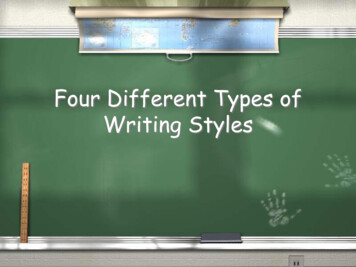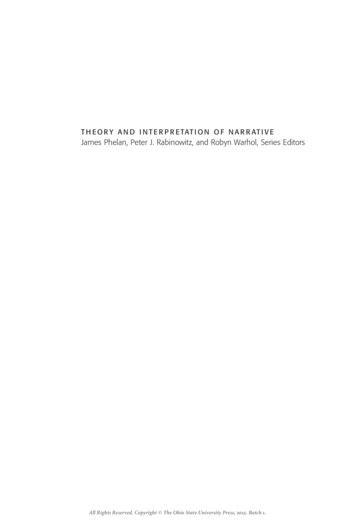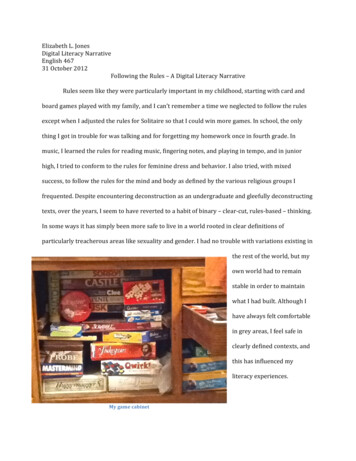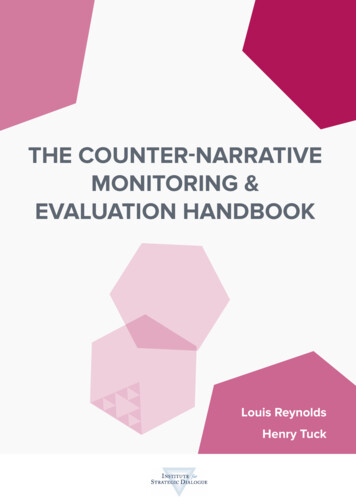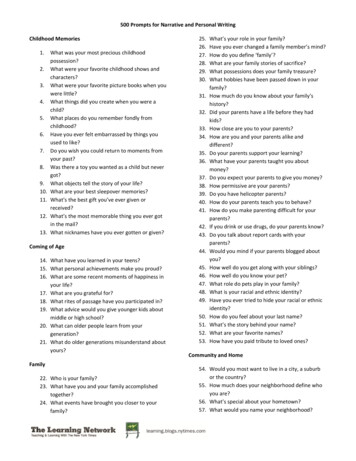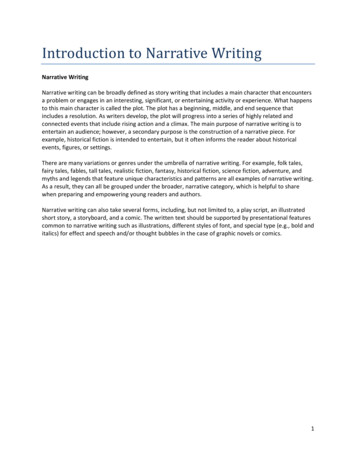
Transcription
Introduction to Narrative WritingNarrative WritingNarrative writing can be broadly defined as story writing that includes a main character that encountersa problem or engages in an interesting, significant, or entertaining activity or experience. What happensto this main character is called the plot. The plot has a beginning, middle, and end sequence thatincludes a resolution. As writers develop, the plot will progress into a series of highly related andconnected events that include rising action and a climax. The main purpose of narrative writing is toentertain an audience; however, a secondary purpose is the construction of a narrative piece. Forexample, historical fiction is intended to entertain, but it often informs the reader about historicalevents, figures, or settings.There are many variations or genres under the umbrella of narrative writing. For example, folk tales,fairy tales, fables, tall tales, realistic fiction, fantasy, historical fiction, science fiction, adventure, andmyths and legends that feature unique characteristics and patterns are all examples of narrative writing.As a result, they can all be grouped under the broader, narrative category, which is helpful to sharewhen preparing and empowering young readers and authors.Narrative writing can also take several forms, including, but not limited to, a play script, an illustratedshort story, a storyboard, and a comic. The written text should be supported by presentational featurescommon to narrative writing such as illustrations, different styles of font, and special type (e.g., bold anditalics) for effect and speech and/or thought bubbles in the case of graphic novels or comics.1
Student Samples – Level 1Students working within Level 1 are expected to meet criteria in some writing usually with support.Level 1cLiTTLe clouDInterpretation:one BriT BiTFLO DAY LiTTLe ClouD was inThe sci BuT he grop in The goonLittle CloudFirST he TernDin To a BiTFLBOTer Fly.a LiTTLe wiLD Literhe Tern in Toa WOgLy keLPiterFinally he TernDin a BAD BeeNow iT STOrT TO rain TO FiD ThePlentOne bright beautiful day little cloud was inthe sky but he drop in the groundFirst he turnedinto a beautifulbutterfly.A little while laterhe turn intoa wiggly caterpillarFinally he turnedin a bad beeNow it start to rain to feed theplant2
Assessment Commentary: AF1: Ideas & Voice – Write imaginative, interesting, and thoughtful textsThe elements of the story (character, setting, problem, events, and solution) are generally related. The authorattempts to add some detail through descriptive words and time order phrases.The author attempts to show his/her unique voice through detailed and distinctive pictures and word choices(e.g., “bright, beautiful day” and “a little while later”).AF2: Organisation – Produce texts which are appropriate to task, reader, and purposeThe piece of writing does not seem to be directed to a specific audience and the author’s voice is similar towhat one would expect if the author was writing within another text type. For instance, some of the sentencesare similar to what would be written in a recount text.The title connects directly with the content and is modelled straight from a mentor text.AF3: Organisation – Organise and present whole texts effectively, sequencing and structuringinformation, ideas and eventsThe piece has a short opening that states the character, setting, and problem.The basic events are in logical order; however, the closing is disconnected and unrelated to the opening andthe events.The closing is a short sentence; however, it could also be interpreted as an additional event rather than aclosing.AF4: Organisation – Construct paragraphs and use cohesion within and between paragraphs The author uses simple linking words (e.g., first, finally, and now) and a linking phrase (e.g., a little whilelater ).The author uses return sweep.AF5: Sentence Fluency – Vary sentences for clarity, purpose, and effectThe author writes his/her thoughts in full sentences.The author’s tense is inconsistent. Past tense is sometimes used in the text, but present tense verbs are usedalso.One connective (e.g., but) is used in the text.AF6: Conventions – Write with technical accuracy of syntax and punctuation in phrases, clauses, and sentences The author shows little awareness of full stops and places only one full stop throughout the entire text. The author shows little awareness of capital letters to begin sentences. Capital letters are also inappropriatelyplaced within sentences. AF7: Word Choice – Select appropriate and effective vocabularyThe author includes a variety of adjectives, such as “bright,” “beautiful,” “little,” and “bad.”The author uses a few action verbs, such as “turned,” “dropped,” and “feed.”The author attempts to use some adventurous words, such as “wiggly.”AF8: Conventions – Use correct spellingMost high frequency words are spelled correctly (e.g., “one,” “little,” “in,” “the,” “now,” and “first”) and somephonetically plausible attempts are made for unknown words (e.g., “ternd” turn, “sci” sky). The words“kelpiter” for caterpillar demonstrate the need for additional instruction in segmenting sounds in words inorder to make phonetically plausible attempts.The author may have referred to classroom resources, such as a word wall.AF9: Presentation - Handwriting and presentation3
This author would benefit from additional instruction in handwriting, as some letters are being formedincorrectly, such as “e,” and the author relies heavily on capital letters throughout the text, which indicatesthat he/she is not familiar enough with lowercase letters.The author uses developmentally appropriate presentational features, including illustrations throughout thetext.Where to Next? Identifying Targets for this Student: AF 6 – The author should work towards including full stops at the end of sentences. This will becomeparticularly important when the graphic organiser scaffold is removed. The author also requires adeeper understanding of capital letters and their appropriate usage. AF 2 – The author used the exact title from the mentor text, Little Cloud, by Eric Carle. Furtherinstruction in developing a unique title would help this author reach higher achievement levels. Theauthor could be exposed to new ideas through shared writing experiences and class discussions.4
Level 1bThe fiSh askapedOne day. Swimee was finingfood. He soa food haningon tip of the se. Swimee swimedas fost as he can Suddenlyhe got cot loce he had Shorpteeth so he bit hroo the net andhe wos free and the fish swamhaple!Interpretation:The Fish EscapedOne day Swimee was findingfood. He saw food hangingon top of the sea. Swimee swimedas fast as he can Suddenlyhe got caught Lucky he had sharpteeth so he bit through the net andhe was free and the fish swamhappily!5
Assessment Commentary: AF1: Ideas & Voice – Write imaginative, interesting, and thoughtful textsThe elements of the story (character, setting, problem, events, and solution) are related. While the characterand setting are not well developed, the problem, events, and solution are distinct and highly logical. Theauthor attempts to add some detail through descriptive words.The author’s writing is beginning to sound unique, which is made evident through the author’s word choice.The use of words such as “luckily” and “happily,” as well as phrases like “as fast as he can,” show someuniqueness of voice; however, the author was not given the opportunity to showcase his/her unique writingvoice through illustrations and pictures.AF2: Organisation – Produce texts which are appropriate to task, reader, and purposeThe author is beginning to demonstrate an understanding of writing to a particular audience and for aparticular purpose. The text is lively, amusing, and is beginning to entertain the reader, which are allappropriate aspects of the text-type and genre.The title directly connects to the content of the text and reveals a major event of the plotline.AF3: Organisation – Organise and present whole texts effectively, sequencing and structuringinformation, ideas and eventsThe piece has a short opening statement that reveals basic information of the character and setting. Theauthor relies on the common opening phrase, “One day.”The author is beginning to develop a plot which includes events in a logical order. The events are connectedand related. The problem is solved in the end.The short closing is merged with the final event of the story and is predictable.AF4: Organisation – Construct paragraphs and use cohesion within and between paragraphs The author attempts to use increasingly interesting linking words, such as “suddenly” and “luckily,” but theapplication of linking words is limited. Additional linking words would add coherence and show the passage oftime more effectively.The author effectively uses return sweep to organise his/her sentences.AF5: Sentence Fluency – Vary sentences for clarity, purpose, and effectThe author writes his/her thoughts in short, full sentences; however, the majority of sentences begin in asimilar way, either with “Swimee” or “he.”The author shows some awareness of simple past tense and accurately changes into past continuous tense,but there are some inconsistencies with the usage of irregular past tense and with the author’s ability toremain in the past tense (evident in phrases like, “Swimee swimed as fast as he can ”).The author uses two connectives to create a compound sentence, including “so” and “and,” but overusesconnectives to create a run-on sentence at the end of the text.AF6: Conventions – Write with technical accuracy of syntax and punctuation in phrases, clauses, and sentences The author has an inconsistent understanding of full stops. He/she places one after the opening phrase (e.g.,“One day”) and omits a full stop at the end one sentence. The author uses an exclamation mark to concludethe text. The author generally uses capital letters appropriately, including at the beginning of sentences (when markedwith a full stop) and for the character’s name. Some teacher judgment is needed to determine inconsistenciesin letter size or if the letters were being used as capital letters, especially with the letter ‘s.’6
AF7: Word Choice – Select appropriate and effective vocabularyThe author includes a limited range of adjectives, only describing the fish teeth (e.g., sharp teeth). The authorshould work towards including more descriptive language.Although not always written in the appropriate tense, the author uses some action verbs (e.g., “finding,”“hanging,” “swim,” and “bit”) and is beginning to experiment with adverbs (e.g., “happily,” “luckily,” and“suddenly”).The author generally uses simple vocabulary and attempts to make the writing more entertaining with thephrase “as fast as he can.”AF8: Conventions – Use correct spellingMost high frequency words are spelled correctly (e.g., “one,” “day,” “he,” “on,” “the,” “can,” “got,” and “and”)and some phonetically plausible attempts are made for unknown words (e.g., “haple” ‘happily’). Additionalphonics instruction with vowel sounds is necessary, as the author often misuses ‘o’ for ‘a’.He/she may have referred to classroom resources, such as a word wall, as particularly evidenced by the word“suddenly.”AF9: Presentation - Handwriting and presentationThe author effectively places letters on the lines, including letters that fall below the lines; however, theletters are not of uniform size. He/she needs improvement in word spacing as it will allow the text to be readwith greater ease.The author does not utilize common presentation features appropriate for narrative writing. This could be dueto the writing materials provided to the author.Where to Next? Identifying Targets for this Student: AF 9 – The author should work towards using more consistent spacing between his/her words, sothe writing is easier to read and flow is not interrupted. The teacher can demonstrate the spaghettiand meatball analogy and further provide the author with a tactile spacer as a temporary scaffold(see Teaching Possibilities in the Guidance on Effective Writing Instruction). AF 7 – The author has included a very limited number of adjectives in this piece. The author’sachievement level will improve with the addition of more descriptive words and an expandedvocabulary.7
Level 1a8
Assessment Commentary: AF1: Ideas & Voice – Write imaginative, interesting, and thoughtful textsThe elements of the story (character, setting, problem, events, and solution) are related with limitedelaboration. While the simple problem and solution are clear and distinct, the events repeat the problem andsolution and provide few additional details as to how the problem was solved.The author is beginning to express individuality through the included illustration and some interesting wordchoices, including “tip tip top.”AF2: Organisation – Produce texts which are appropriate to task, reader, and purposeThis piece of writing does not seem to be directed to a specific audience and the author’s voice is similar towhat one would expect if the author was writing within another text type.The author gives the text a simple title, but the title is unrelated to the ideas of the story.AF3: Organisation – Organise and present whole texts effectively, sequencing and structuringinformation, ideas and eventsThe author includes an opening that attempts to use the simple hooking strategy of character’s dialogue (e.g.,“can you teach me how to Climb Said the ugle egona”).The events are connected, but are incomplete and leave the reader wondering how the character learned toclimb the tree. The reader is left confused by the repetitiveness of ideas and the multiple references to thesame character (e.g., “ugly iguana,” and “George”).The author includes a short sentence for the closing that is predictable and abrupt.AF4: Organisation – Construct paragraphs and use cohesion within and between paragraphs The author uses simple, generic linking words (e.g., “first,” “next,” “then,” and “finally”) to attempt tosequence events.The author effectively uses return sweep to organise his/her sentences and is beginning to group ideas into anopening, a sequence of events, and a closing. The author has separated each event into its own group;however, this is an awkward text structure, as each event is only one sentence, and would be moreappropriate if the author included the events.AF5: Sentence Fluency – Vary sentences for clarity, purpose, and effectThe author writes his/her thoughts in full sentences but relies on starting with the linking word, followed by“George.”Most of the text is written in the simple past tense but there are a few instances in which the author uses“can” instead of “could.” The author also demonstrates the ability to switch into the appropriate tense incharacter dialogue, as used in the hook.“Because” is used as a connective to create a compound sentence in the closing.AF6: Conventions – Write with technical accuracy of syntax and punctuation in phrases, clauses, and sentences The author correctly uses full stops at the end of each sentence but omits the question mark required in theopening character dialogue. The author consistently begins sentences with capital letters and uses a capital for proper nouns (e.g.,“George”). AF7: Word Choice – Select appropriate and effective vocabularyThe author is beginning to include a few simple adjectives in his/her writing (e.g., “ugly” and “happy”). Moreemphasis on including describing words will help the student achieve more.The author uses some action verbs (e.g., “teach,” “climb,” “tried,” and “felt”).The author relies on simple vocabulary and high frequency words.9
AF8: Conventions – Use correct spellingMost high frequency words are spelled correctly and phonetically plausible attempts are made for unknownwords. The text is understandable and readable.The author may have referred to classroom resources, such as a word wall.AF9: Presentation - Handwriting and presentationThe author was not required to write on lines as specified in the Ministry’s handwriting policy. Word spacing isappropriate throughout the text. Further instruction on descenders/letters that go below the baseline,particularly ‘g,’ will be helpful for the author.The author includes a simple illustration.Where to Next? Identifying Targets for this Student: AF 1 – The author needs to expand his/her ideas to include more events instead of simplerepetition. The author also needs to incorporate additional details for each of those distinct andindependent, yet related, events. This will help to keep the reader interested. The ability to developideas is critical to the author’s success as a writer. AF 5 – The author should be encouraged to create compound sentences with connectives like “and,”“but,” and “so.” Experimenting with starting his/her sentences in a few different ways will help theauthor improve and include more detail and elaboration in his/her writing.10
Student Samples – Level 2Level 2c11
Assessment Commentary: AF1: Ideas & Voice – Write imaginative, interesting, and thoughtful textsThe elements of the story (characters, setting, problem, events, and solution) are related and the author isbeginning to provide some elaboration and detail. While the characters and setting are not well developed,the problem, events, and solution are distinct and highly logical.The author expresses individuality and a writer’s voice through the included detailed picture, but should alsobegin to include interesting word choices and varying punctuation marks.AF2: Organisation – Produce texts which are appropriate to task, reader, and purposeThe author is beginning to demonstrate an understanding of writing to a particular audience and for aparticular purpose. The text is beginning to entertain the reader.The author’s title catches the reader’s attention by creating a sense of suspense and is related to the contentof the text.AF3: Organisation – Organise and present whole texts effectively, sequencing and structuringinformation, ideas and eventsThe author includes an opening for the narrative by introducing the main character and setting the scene,which is appropriate for the text-type. Greater detail and more information about the character and settingwould improve this text.The author is beginning to develop a plot which includes simple events in a logical order. The events areconnected and related and the problem is solved in the end.While the author includes a simple closing, the ending of the text is abrupt and the author could expand thesentence to leave the reader with a sense of closure (e.g., “It grew into a mommy turtle but alwaysremembered that kind man who chased the mean bird away”).AF4: Organisation – Construct paragraphs and use cohesion within and between paragraphs The author attempts to use increasingly interesting linking words, such as “many years ago,” “one night,” and“suddenly;” however, the application of linking words is limited throughout the entire text. Additional linkingwords and phrases would add coherence and show the passing of time more effectively.The author effectively uses return sweep to organise his/her sentences but needs to work towards groupinghis/her ideas into a beginning, a middle, and an end.AF5: Sentence Fluency – Vary sentences for clarity, purpose, and effectThe author writes his/her thoughts in short, full sentences, and though she/he mostly relies on startingsentences with a noun, she/he begins sentences in a few different ways.The majority of the text is written in simple past tense and the student demonstrates an understanding ofregular and irregular past tense verbs with only a few exceptions.The author has not included connectives to join two independent clauses to form a compound sentence.AF6: Conventions – Write with technical accuracy of syntax and punctuation in phrases, clauses, and sentences The author correctly uses full stops at the end of each sentence and experiments (though inappropriately)with using an exclamation mark in the title. The author consistently begins all sentences with capital letters and correctly uses capital letters in the title.The characters are not named; therefore, the use of capital letters for proper nouns cannot be assessed. The author has not demonstrated an understanding of commas as no opportunities for using commas in a listare present. Using multiple adjectives in a list to describe the character or setting could be introduced to theauthor (e.g., “Many years ago, a fat, brown, Logger Head mother turtle laid hundreds of eggs in the soft, whitesand”).12
AF7: Word Choice – Select appropriate and effective vocabularyThe author uses some basic adjectives to add detail to his/her writing (e.g., “fat,” “cute,” “mean,” “and big”).The author uses a variety of action verbs (e.g., “laid,” “hatched,” “flew,” “saw,” “chased,” and “relived”).The author is beginning to use some adventurous word choices, particularly involving verbs.AF8: Conventions – Use correct spellingMost high frequency words are spelled correctly and phonetically plausible attempts are made for unknownwords. A review of some vowel patterns (e.g., “ea” in ‘year’ and “igh” in ‘night’) will help this author’s spellingimprove.The author may have referred to classroom resources, such as a word wall.AF9: Presentation - Handwriting and presentationThe author effectively places letters on the lines, including letters that fall below the lines, and he/sheaccurately sizes upper and lower case letters. Word spacing is accurate and consistently applied throughoutthe text.The author includes a simple illustration that depicts one of the main events.Where to Next? Identifying Targets for this Student: AF 5 – The author should be encouraged to create compound sentences with connectives such as“and,” “but,” and “so.” Experimenting with starting sentences in a few different ways will help thisstudent improve and include more detail and elaboration in his/her writing. AF 4 – Grouping ideas into an opening, a middle, and a closing will allow the author to progressthrough Level 2 criteria. Structuring the text in this manner is likely help the author include moredetails in each section and is highly applicable across all text-types.13
Level 2b14
15
Assessment Commentary: AF1: Ideas & Voice – Write imaginative, interesting, and thoughtful textsThe elements of the story (e.g., character, setting, problem, events, and solution) are related and the author isbeginning to provide some elaboration and detail. While the characters and setting are not well developed,the problem, events, and solution are imaginative and well-suited for the narrative text-type.The author’s writing is beginning to show uniqueness through creative ideas; however, he/she has yet todevelop his/her personal writing voice. The author will progress in this trait with the use of interestingconventions, word choice, and sentence fluency.AF2: Organisation – Produce texts which are appropriate to task, reader, and purposeThe author is beginning to demonstrate an understanding of writing to a particular audience and for aparticular purpose. The text is imaginative, amusing, and is beginning to entertain the reader. These featuresare appropriate to the text-type and genre.The author’s title catches the reader’s attention and sparks curiosity in the reader.AF3: Organisation – Organise and present whole texts effectively, sequencing and structuringinformation, ideas and eventsThe author includes an opening for the narrative by introducing the main character and the problem, which isappropriate for the text-type. For greater effect, the author could include a simple hooking strategy to moreeffectively capture the reader’s attention. This would also add greater detail. The author should also beencouraged to abandon the overused phrase, “One day.”The events of the narrative are connected and are in logical order but the reader needs to infer the resolutionto the problem (e.g., the rain made enough water for the character to brush her teeth).The author includes a closing with details of the lesson learned; however, the lesson does not relate to theoriginal problem stated in the opening of the text. The lesson learned in the closing relates to the blue drop,while the problem in the opening relates to the character Gab.AF4: Organisation – Construct paragraphs and use cohesion within and between paragraphs The author uses some generic linking words and is beginning to use a few more complex linking words (e.g.,“one day,” “first,” “suddenly,” “lastly,” and “now”) to transition to the next event. The linking words used donot yet effectively depict the passage of time.The author effectively groups his/her ideas into a beginning (opening), a middle (events), and an end (closing).AF5: Sentence Fluency – Vary sentences for clarity, purpose, and effectThe author consistently writes his/her thoughts in full sentences which begin in a few different ways. Theauthor’s sentences are generally similarly structured (with the exception of the closing) and further instructionin varying sentence length and complexity will help this author continue to improve.The text is written in simple past tense and the student demonstrates an understanding of regular andirregular past tense verbs.The author writes a few compound sentences by using “and” and “so” to connect two independent clauses. Attimes, the author overuses connectives and creates run-on sentences.AF6: Conventions – Write with technical accuracy of syntax and punctuation in phrases, clauses, and sentences The author correctly uses full stops at the end of sentences but has not yet used exclamation marks orquestion marks. The author consistently begins all sentences with capital letters and correctly uses capital letters for propernouns and in the title. The author uses a comma in a short list of adjectives and shows a limited awareness of using commas to mark16
clauses (e.g., the comma used in the closing). AF7: Word Choice – Select appropriate and effective vocabularyThe author uses a variety of simple, basic adjectives (e.g., “warm,” “bright,” “little,” and “red”); however, theauthor has yet to experiment with more interesting descriptive words. Adding more adjectives will help thisstudent improve.The author includes a variety of basic action verbs (e.g., “brush,” “called,” “told,” “tried,” “came,” “blew,”“fell,” and “learned”).The author relies on simple vocabulary to express ideas and adventurous word choices are limited in the text. AF8: Conventions – Use correct spellingOverall, spelling is generally accurate throughout the text, with limited exceptions.He/she may have referred to classroom resources, such as a word wall. AF9: Presentation - Handwriting and presentationThe author writes on the lines correctly and letters are formed, oriented, and sized correctly. Words arespaced accurately.The author includes a simple illustration that depicts the character.Where to Next? Identifying Targets for this Student: AF 7 – The addition of more adjectives and stronger word choices will help this author’s writingimprove. Additional adjectives will also help to add a sense of voice and individuality to the text. AF 6 – Encouraging the student to include a wider variety of punctuation marks at the end ofsentences will add voice to the text and help him/her progress through Level 2 criteria.17
Level 2a18
Assessment Commentary: AF1: Ideas & Voice – Write imaginative, interesting, and thoughtful textsThe elements of the story (characters, setting, problem, events, and solution) are related and the authorprovides some elaboration and detail. More detail (e.g., the curse) is necessary to clearly connect the ideas inthe text to the problem without the reader having to infer.The author is beginning to develop his/her personal voice and his/her writing is beginning to sound uniquethrough the use of some interesting conventions (e.g., “She burned her finger on the stove!”) and someinteresting and topic appropriate word choices (e.g., “potion out of flower, joy and love”).AF2: Organisation – Produce texts which are appropriate to task, reader, and purposeThe author is beginning to demonstrate an understanding of writing to a particular audience and for aparticular purpose. The text is lively, amusing, and is beginning to entertain the reader, as appropriate for thetext-type and genre.The author’s title catches the reader’s attention but is directly related to the problem of the text.AF3: Organisation – Organise and present whole texts effectively, sequencing and structuringinformation, ideas and eventsThe author includes an opening for the narrative by introducing the main character and the problem, which isappropriate for the text-type. For greater effect, the author could include a simple hooking strategy to moreeffectively capture the reader’s attention and add greater detail.Most of the events are connected, but require inferring from the reader to understand their connection to theresult of the curse.The author includes a short, one-sentence closing after the resolution and attempts to provide additionaldetail.AF4: Organisation – Construct paragraphs and use cohesion within and between paragraphs The author uses a combination of simple, generic linking words (e.g., “next” and “then”) and longer linkingphrases (e.g., “every night, “one day,” and “that evening”) to signal the passage of time and to organise theevents effectively.The author effectively groups his/her ideas into a beginning (opening), a middle (events), and an end (closing),and is experimenting with breaking sections into paragraphs.AF5: Sentence Fluency – Vary sentences for clarity, purpose, and effectThe author writes his/her thoughts in full sentences and usually begi
Narrative writing can also take several forms, including, but not limited to, a play script, an illustrated short story, a storyboard, and a comic. The written text should be supported by presentational features common to narrative writing such as illustrations, d
